There are several cow breeds with white coats. While some of them have pure white coats, others have white coats mixed with black or brown.
White cow breeds are not a rare sight; they are pretty easy to come by. But if you are looking to get one for your farm, it would not hurt to learn more about your options.
To help with this, we compiled a list of 11 white cow breeds. We run through their origins, physical features, uses, and much more.
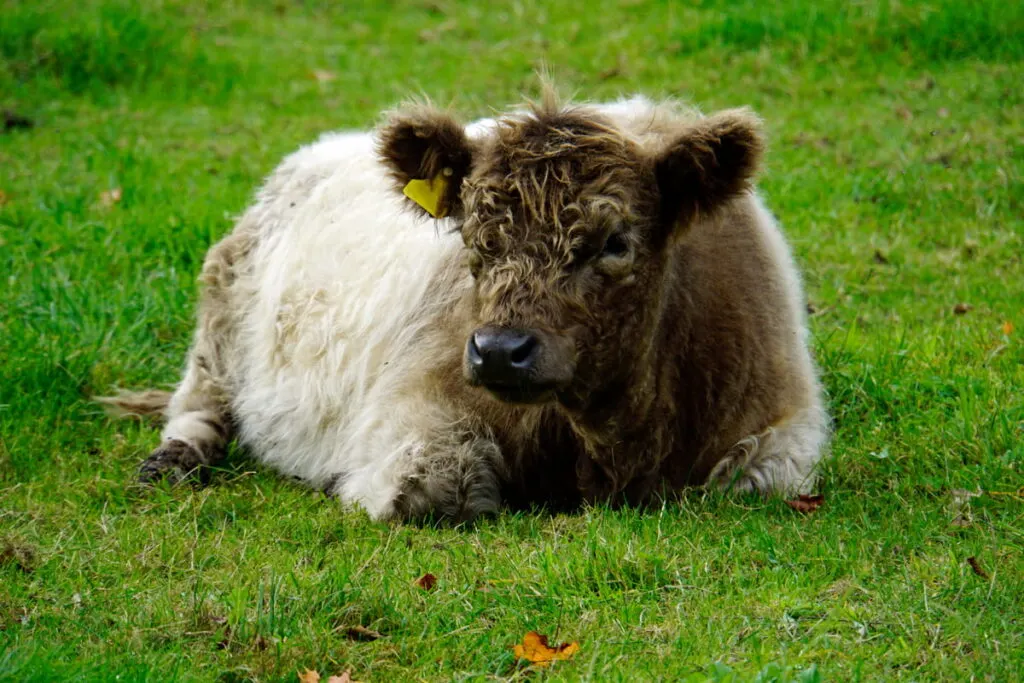
Table of Contents
White Galloway
The Galloway is an established cow breed indigenous to Scotland. The Galloway is hardy and can thrive on rough forage and limited grasses. It is adapted well to the damp and harsh climate of its native environment.
Although the most common color of this cow breed is black, they also appear in red, dun, and white with distinct black points. The White Galloway has a white, shaggy coat with black points around its nose, eyes, and ears. Sometimes its udder, poll, and tail may have some color.
At maturity, male White Galloway Cattle can weigh around 1790 pounds while females weigh 1250 pounds. Males can reach about 4.5 feet in height, with females reaching 4 feet.
White Galloway Cows are hornless and naturally polled. Their shaggy coats have a thick and wooly undercoat that offers warmth, allowing them to adapt to harsher climates. White Galloway Cows are raised for dairy and meat production.
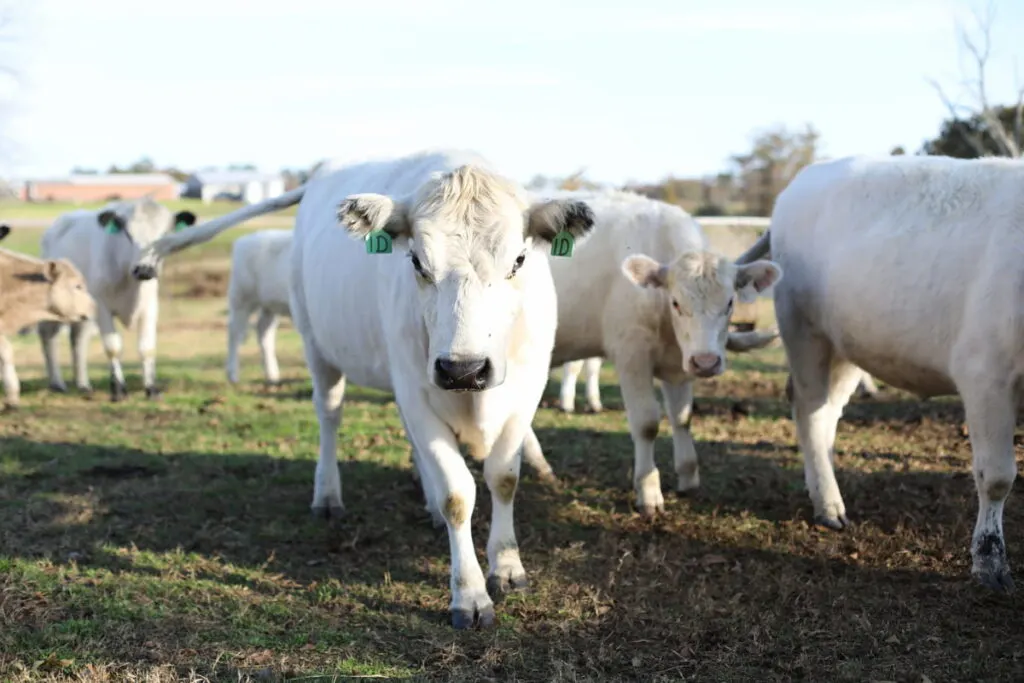
British White
The British White cattle is an old British breed directly linked to the ancient white cattle of Great Britain. It is native to Whalley Abbey, Lancashire.
British Whites are usually white with black points on their tongues, noses, hooves, ears, and eyelids. They also have pink and blue skins. Sometimes their skins have black pigments.
The British White is a large-sized cow breed that is naturally polled. At maturity, British White bulls weigh around 2204 pounds, while cows can weigh 1433 pounds.
British White are hardy, disease-resistant animals. They are dual-purpose breeds and are raised for meat and milk production. The beef obtained from a British White Cow is well known for its excellent texture.
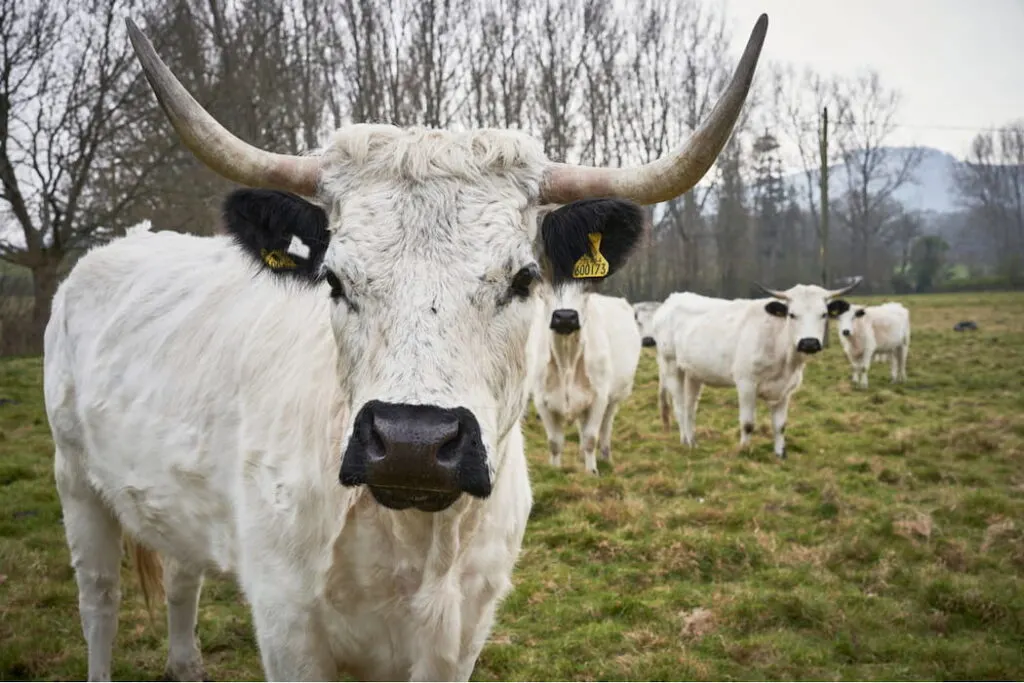
White Park Cattle
The White Park Cow is also known as White Horned, Park, Wild White, and White Forest. There are two uncommon, dissimilar types of this breed: the Vaynol and the Chillingham cattle. White Park cows are thrifty, hardy, and docile.
White Park Cattle are large-sized animals with long bodies. They usually have white coats with black or red points. Both male and female White Park Cattle have large horns.
On average, a mature White Park Bull can weigh around 1763-2204 pounds. Their body weight tends to vary and depends on the grazing quality. Under good grazing conditions, mature bulls weigh about 2755 pounds. White Park Cows are smaller and weigh an average of 1102-1543 pounds.
White Park Cattle are dual-purpose animals and are excellent for milk and meat production. They produce high-quality beef, and they are also ideal for conservation grazing.
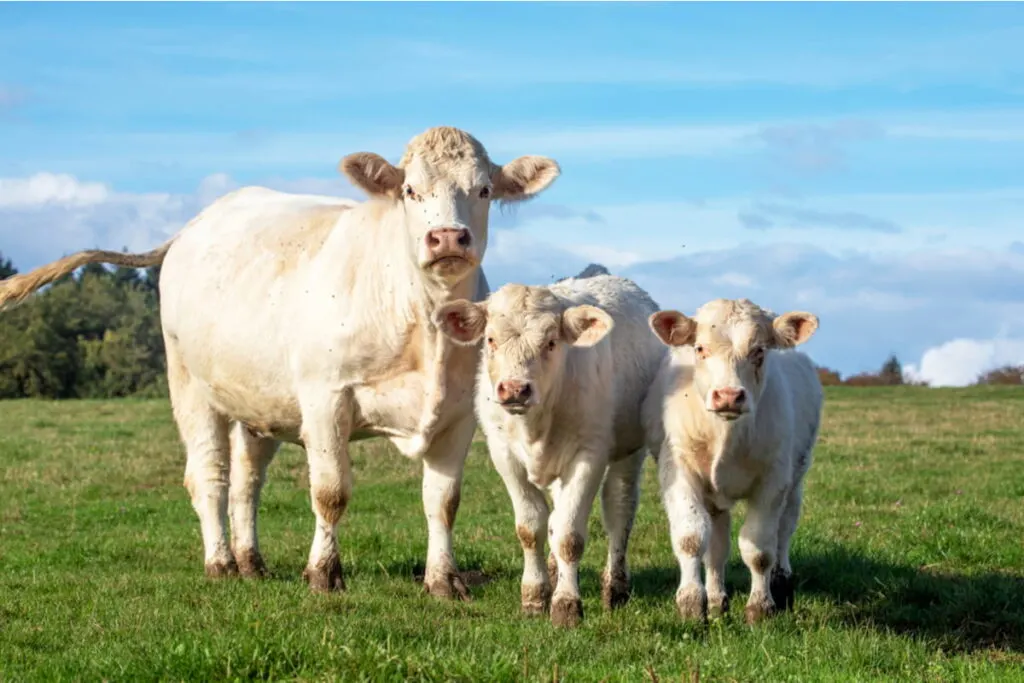
Charolais
The Charolais is a cow breed indigenous to southeastern France. It became popular in French markets in the 16th and 17th centuries. However, legend has it that this breed was first spotted in the region in 878 A.D.
Charolais cattle usually have white coats with pale hooves and pink muzzles. Their coats can also be pink or cream-colored. Currently, there are some Charolais breeds with red and black coats. They have long bodies and are pretty easy to manage due to their temperament.
Charolais are medium to large-sized animals with heavily muscled loins and short heads. They can either be horned or polled. At maturity, a Charolais Bull can weigh around 2200-3600 pounds while cows weigh 1500-2600 pounds.
Charolais are raised for meat production. They are also crossed with other cattle breeds like Hereford and Angus cattle.
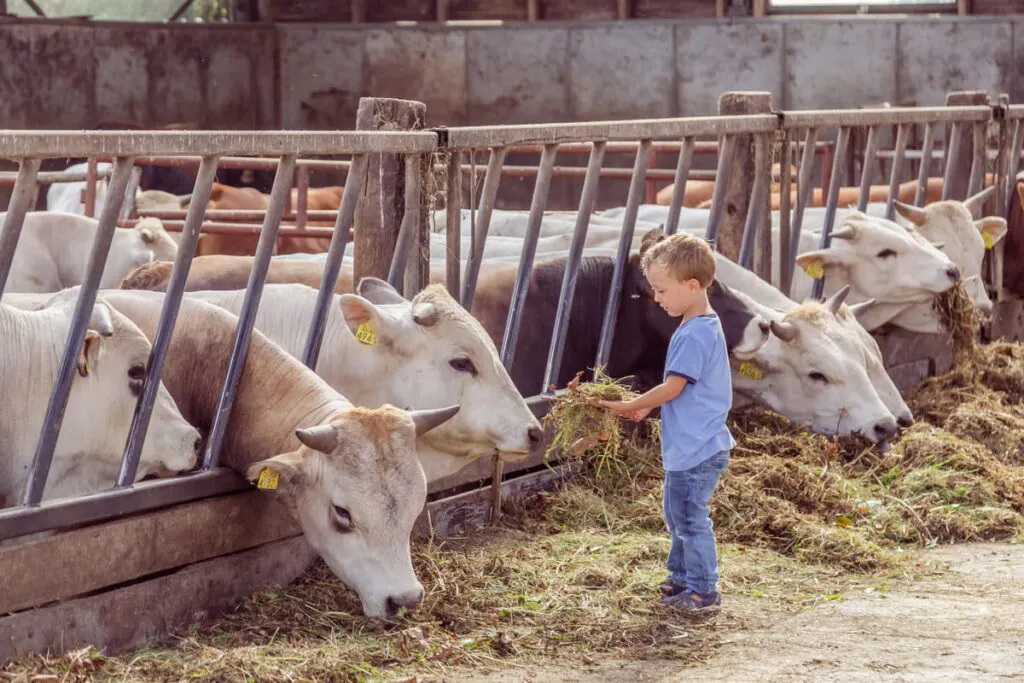
Marchigiana
The origin of the Marchigiana Cattle is unsettled. According to the American International Marchigiana Society, Marchigiana Cattle are descendants of the Asiatic cattle. According to them, these cattle were brought into Italy in the 4th century after the invasion of the barbarians.
Marchigiana cows are similar to the Chianina. They have short-haired coats that vary in color from light grey to white. They also have pigmented skins with black muzzles and tongues. Their tails and the area around their eyes are dark.
Marchigiana Cows can either be horned or polled. The horns are medium-sized with a yellow cast at the base that becomes white and black at the tip.
Marchigiana is a large muscular breed with a fine bone structure. At maturity, Marchigiana Bulls weigh an average of 2,000-2,400 pounds while cows weigh 1,300-1,500 pounds. At birth, Marchigiana Calves weigh an average of 80-85 pounds.
Marchigiana Cows are reared for meat production. Marchigiana Cattle are hardy animals and can adapt well to different terrains and climates.
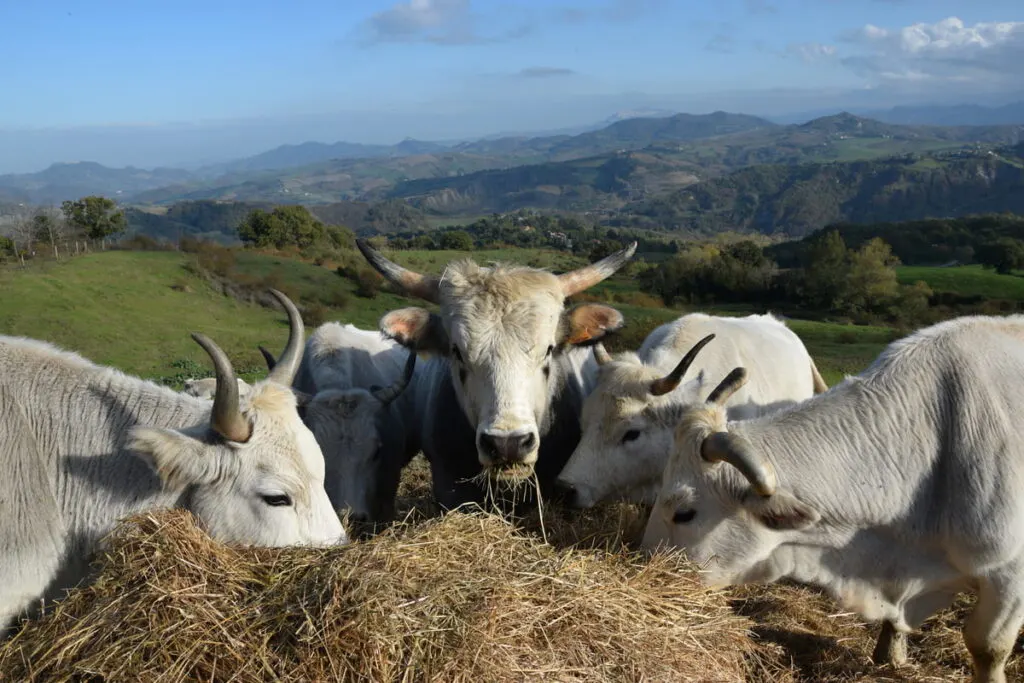
Chianina
Chianina is a cow breed indigenous to the west-central part of Italy. It is found in various environmental conditions, and as a result, it varies in type and size from region to region.
Chianina cattle have white to steel grey, short-haired coats.
Both sexes have dark skin, with black noses, tongues, eye area, and palate. Their dark skins protect them from cancer eye and pink eye. They also have short horns that curve forward. In younger animals, the horns are black but become lighter as they mature.
Chianina cows are well known for their extensive and well-defined muscles. They have well-formed backs, rear quarters, and shoulders. They have long and straight faces with long legs, which are usually longer than most breeds.
A Chianina Cow weighs an average of 1763 to 2204 pounds and stands 4.9 to 5.2 feet at the withers. On the other hand, the bulls weigh 2535 to 2821 pounds and stand 5.2 to 5.7 feet at the withers. It is not uncommon to find bulls over 5.9 feet and cows over 5.2 feet.
Chianina is raised mainly for meat production. Due to their late maturity, it is ideal for producing older and yearling beef. The beef obtained from Chianina cattle is red and free from waste. Due to their small udders, Chianina cattle are not prolific milk producers.
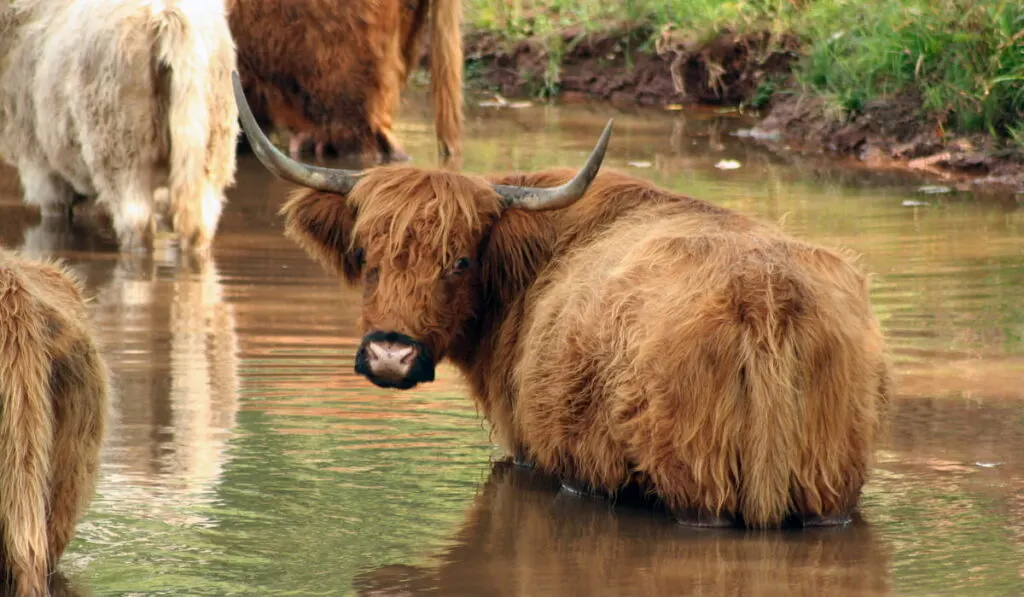
Highland Cattle
The Highland Cattle is a cattle breed native to Scotland. This cow breed is a descendant of the native cattle of Scotland, and its name comes from its native Highland region. Highland Cattle are hardy and active animals due to the environmental conditions of their native environment.
Highland Cattle have long and wavy coats.
The coats come in different colors, including white, dun, black, silver, red, yellow, or brindle. Highland Cattle are also have long horns.
At maturity, Highland Bulls can weigh an average of 1763 pounds, while cows weigh 1102 pounds. The average body height of a Highland Bull is around 3.4-3.9 feet, while cows are usually within the range of 2.9-3.4 feet. The Highland Cattle is reared mainly for meat production.
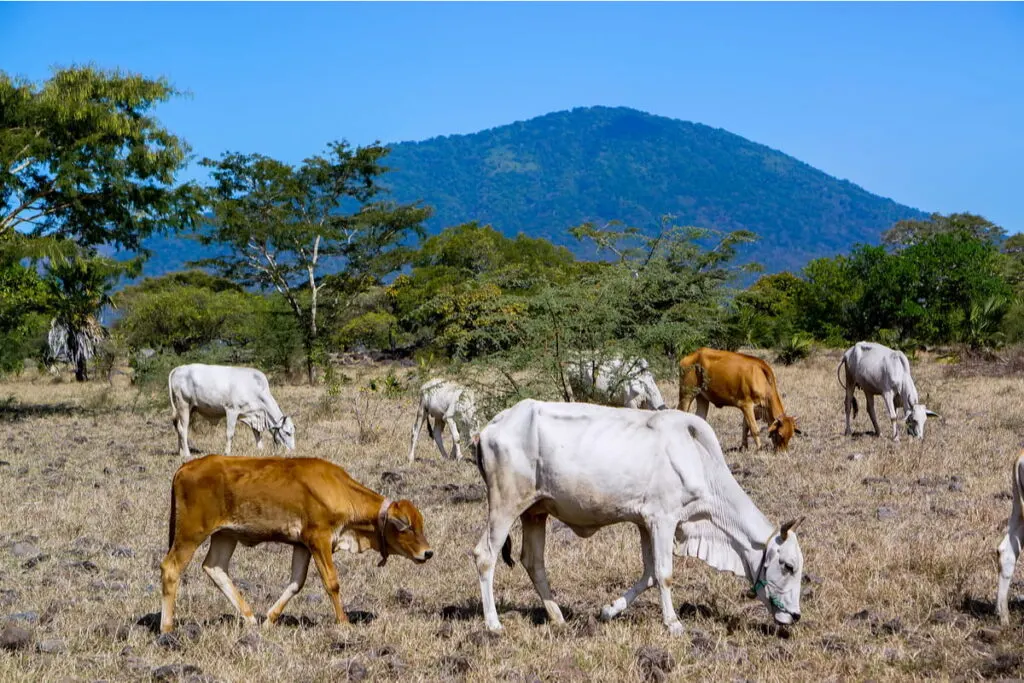
Ongole Cattle
The Ongole breed is native to India, more specifically the Andhra region of Prakasam District in India. However, it is bred and widely distributed in several countries throughout the world.
Ongole Cattle are large-sized animals with loosely knit frames and large dewlaps. They have long and muscular limbs. They also have relatively long bodies and short necks. Their elliptical eyes are surrounded by black skin and covered by black lashes.
The coat of the Ongole Cattle is predominantly white. However, they can appear in several other colors. Bulls tend to have dark grey markings on their humps, heads, and necks. They may also have black points on their knees and the pasterns of their fore & hind legs.
Ongole Cattle have moderately long and slightly dropping ears. Bulls have a well-developed, erect hump.
Ongole Cattle have short and stumpy horns that grow outwards and backward. At maturity, the bulls weigh an average of 1102 pounds, while cows weigh 952-1,003 pounds.
In their native areas, Ongole Cattle are reared for milk production and working purposes. Outside India, this breed is used for meat production. Ongole Cattle are also known for their rapid growth rate, disease resistance, and tolerance to heat.
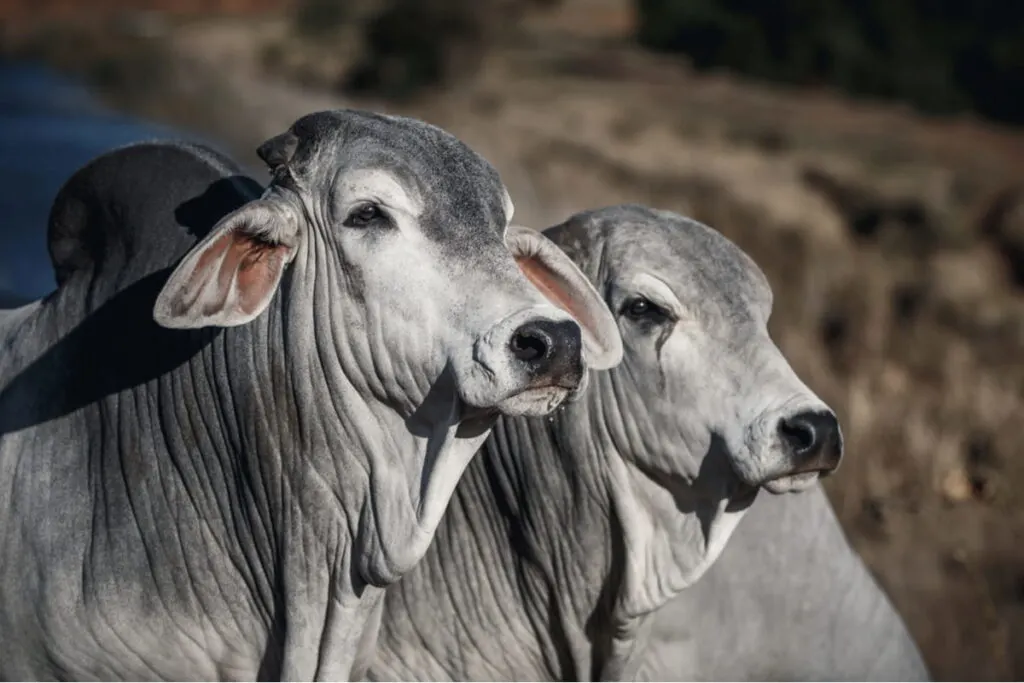
Brahman
The Brahman is a cow breed indigenous to India. It is often called the sacred cattle of India. Despite the constant exposure of this cow to extreme weather, inadequate food supply, diseases, and parasites, it still managed to adapt and survive.
Brahman cattle generally have a large hump over their necks and shoulders. They appear in a variety of colors, including light grey, red or black. Brahman bulls are usually darker than cows, with dark areas on their lower thighs, necks, and shoulders.
Brahman cows have thick glossy hair covering their black pigmented skin. Their loose skin allows them to withstand warm weather, and this is pretty helpful when they graze. The horn of a Brahman Cow curves upwards and will often tilt backward.
Brahman cows are medium-sized animals. Mature Brahman bulls weigh around 1600-2000 pounds, while cows weigh 1000-1400 pounds. At birth, Brahman calves are small and weigh an average of 60-65 pounds.
Brahman cows are shy, curious, and intelligent animals. They are also hardy animals that can adapt to a wide range of climates.
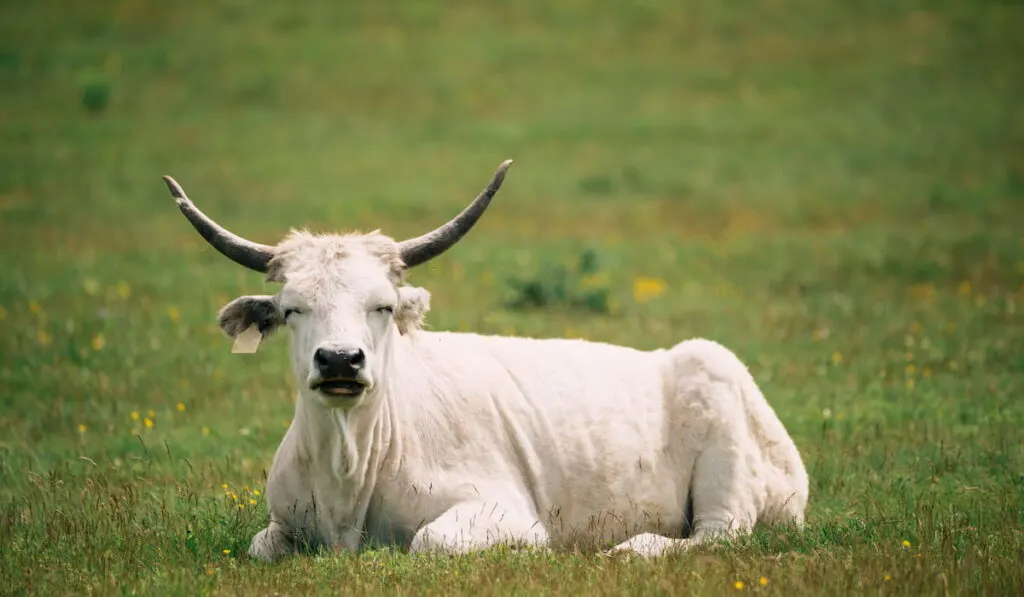
Hungarian Grey Cow
The Hungarian Grey Cows are an ancient domestic cow breed. They live long and are strong, hardy, and ideal for extensive pasture systems.
The Hungarian Grey Cow is also known as Magyar szürkemarha, Hungarian Steppe, Grey Hungarian, or White Hungarian.
Hungarian Grey Cows are small to medium-sized animals. Their coats can range from silvery-white to ash-grey. Their calves are wheat-colored at birth and become grey when they are three months old. Hungarian Grey Cows are tall and slender animals with long horns.
At maturity, Hungarian Grey Bulls weigh an average of 1763-1984 pounds, while cows weigh 1102-1322 pounds. Bulls can reach a height of 4.7-5 feet at the withers, while cows are 4.4-4.8 feet at the withers.
Hungarian Grey Cows were originally dual-purpose animals and were used as draught animals and for producing meat. But currently, these cows are raised mainly for meat production.
Rathi Cattle
Rathi Cattle is a cattle breed native to India. Locally, there are two variants of this breed: Rath and Rathi. While the Rath is a milk-producing variant, the Rathi variant is a draft breed.
Rathi Cattle usually have brown coats with white patches. This cow breed can also have black coats with white patches or completely brown coats. They have horns that curve outward and upward. They also have broad and slightly dished faces.
Rathi Cattle are generally medium-sized animals. At maturity, Rathi Bulls can weigh an average of 771-837 pounds while cows weigh 617-661 pounds.
Rathi cattle are dual-purpose animals reared for draft purposes and milk production. Despite the poor environmental condition of its native environment, this cattle breed has adapted well.
Resources:
- https://www.thecattlesite.com/breeds/beef/11/charolais/
- https://www.thecattlesite.com/breeds/beef/65/marchigiana/
- https://www.roysfarm.com/rathi-cattle/
- https://www.roysfarm.com/hungarian-grey-cattle/
- https://www.roysfarm.com/ongole-cattle/
- https://www.roysfarm.com/white-park-cattle/
- https://www.thecattlesite.com/breeds/beef/44/chianina/
- https://www.thecattlesite.com/breeds/beef/67/brahman/
- https://www.thecattlesite.com/breeds/beef/60/british-white/
- https://www.roysfarm.com/highland-cattle/
- https://www.suncreststud.co.nz/aboutbreed/
